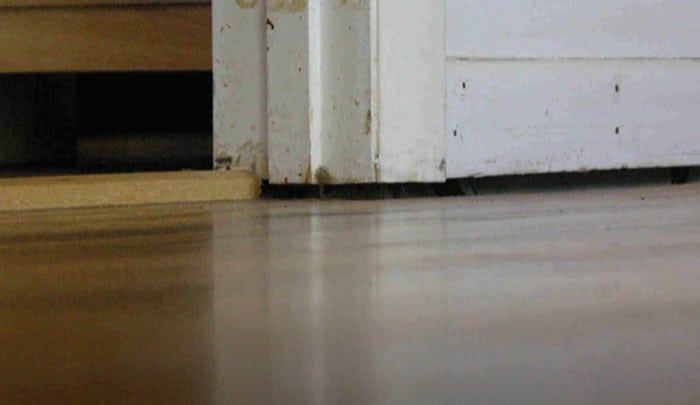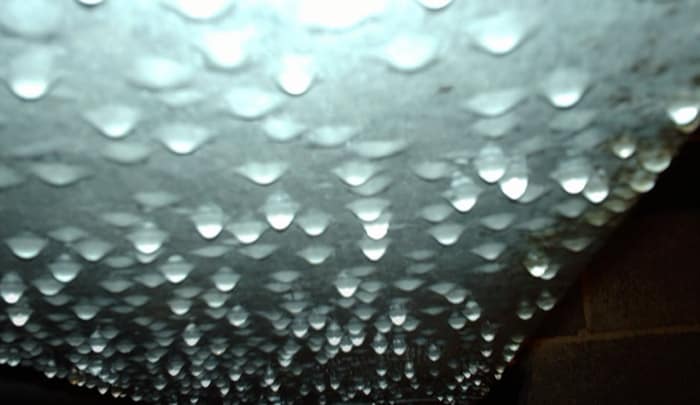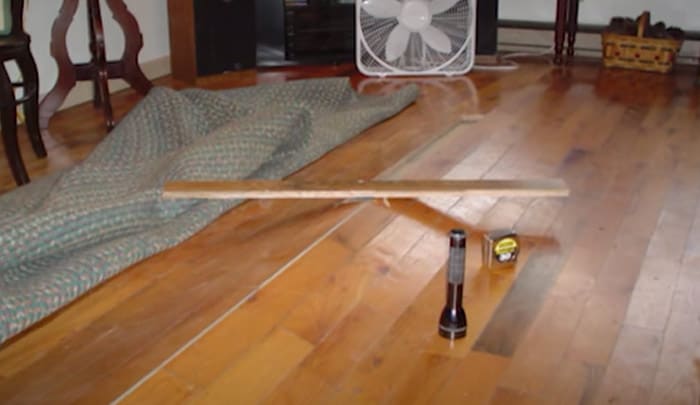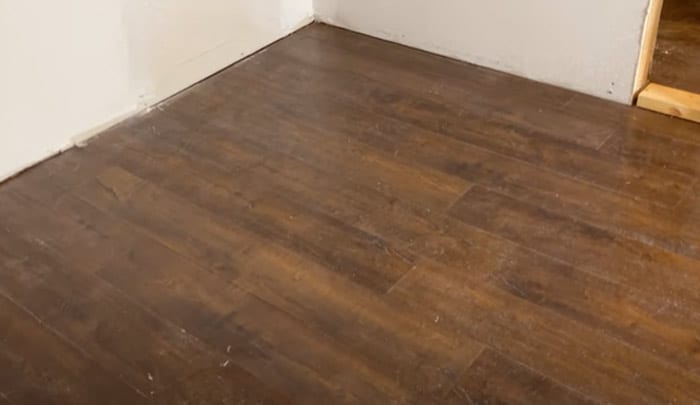It’s the season of outdoor barbecues and beach ball matches, but summertime can also bring a not-so-welcome guest: warped hardwood floors. If your home has hardwood flooring and you’ve noticed buckling or swelling to parts of your floor during the summer, you’re likely wondering what’s going on. But don’t worry, we’ve got your answers! In this blog post, we’ll go over all the possible causes of summertime hardwood floor buckling so that you can understand why it happens and how to fix it. Let’s dive in and find out why your hardwood floors buckle in the summer!
Hardwood floor buckling is often caused by high levels of moisture in the air, which can happen during hot and humid summers. In order to prevent this from happening, try keeping your home humidity levels below 50%.
“There is a common misconception that heat is the primary factor causing hardwood floors to buckle in summer. The main culprit is actually the shift in humidity levels. Wood is hygroscopic, meaning it absorbs and releases moisture from the surrounding environment, which can cause it to expand or contract. Homeowners can mitigate this by maintaining a consistent level of humidity in their homes throughout the year, perhaps through the use of a dehumidifier or two.”
Walter Jameson, Timber Technologist
What is Hardwood Floor Buckling?
Hardwood floor buckling is a phenomenon in which boards of hardwood floors become warped when exposed to excessive moisture. During this process, the adhesive that was initially used to secure the hardwood floor to the subfloor, fails and causes the wood planks to rise up and buckle into an undesirable shape. This phenomenon is caused by a number of factors, varying from excessive moisture in the environment to lack of subfloor ventilation.
Some experts have argued that hardwood floor buckling can be an issue despite proper maintenance due to humidity levels that may go beyond those considered normal. High humidity within a home can cause the boards to absorb too much moisture, leading the wooden planks to expand and buckle against each other. On the other hand, some believe that this phenomenon can be prevented by following instructions on installation and ensuring that owners properly maintain their floors. For example, owners should place area mats near entrances as well as take precautionary steps such as using floor protectors and vacuuming regularly. It’s also important for homeowners to keep an eye on any leaking pipes or water spills since these can lead to long-term water damage and potentially buckling of the hardwood floors
Ultimately, both sides agree that hardwood floor buckling has many causes that range from environmental factors such as humidity levels or poor installation techniques which contribute to inadequate ventilation beneath the floors. To finish out this section let’s take a moment to explore further how these environmental factors can influence hardwood floor buckling before transitioning into understanding what might actually cause it: The next section will be focused on “Causes of Hardwood Floor Buckling”.

Causes of Hardwood Floor Buckling
Generally, hardwood floor buckling occurs when boards are exposed to varying levels of moisture. As wood can swell and expand with increased moisture levels, the boards raise up from their subfloor causing gaps and buckling if the rate of expansion is faster than the subfloor can handle. This can be attributed to a variety of causes; however, it is more commonly attributed to high humidity levels in the home or office space.
One argument asserts that fluctuating temperatures can also lead to hardwood floor buckling as this increases the chance of condensation on the coldest parts of the floor (near windows) which further adds to existing humidity levels. Additionally, homeowners should be aware that previously damaged or deteriorated subfloors may result in higher rates of buckling due to increased water absorption.
However, proponents of this argument believe that this type of buckling is less common due to better construction practices and improved building envelope designs that limit extreme temperature swings and reduce air leakage throughout building cavities. Nonetheless, an increase in humidity levels will still create conditions where boards will expand and cause surface buckling.
Given these potential causes, it is clear that hardwood floor buckling is primarily caused by high humidity levels. In the next section we will discuss high humidity levels in greater detail and look at ways to reduce hardwood floor damage through proper maintenance and preventive measures.
High Humidity Levels
High humidity is one of the main culprits for buckled hardwood floors in the summer. High humidity levels can cause the hardwood floorboards to swell and warp, which is a major contributor to buckling. It’s important to maintain an indoor relative humidity level below 65%, as levels any higher will gradually cause degradation of hardwood flooring over time. When it comes to prevention and treatment of buckled boards, improvements to indoor humidity control should be the first step taken.
Humidity can also contribute to warping in more subtle ways. Wood, like any material, is expandable and contractible based on temperature and moisture content; when high humidity penetrates the wood surface, it causes moisture absorption that expands the cell walls causing the wood to swell, resulting in high-stress levels leading to buckling. Proper ventilation with good climate control can help regulate these levels and prevent this type of rot and damage.
Though it may seem beneficial to reduce humidity all together, sudden or drastic changes in humidity can be destabilizing and lead to further issues such as cracking or cupping due to the tendency of various woods to shrink or swell based on varying relative humidities. Maintenance of indoor relative humidity should thus be done gradually, allowing your wood flooring too adjust accordingly while avoiding damages associated with large fluctuations of RH.
With this in mind, it’s clear that consistently managing indoor humidity levels is essential for keeping your hardwood floors healthy and protected from warping and buckling during times when outdoor temperatures soar and summer months bring added moisture. This leads us nicely into our next discussion about how changes in temperature could be affecting your hardwood floors.
Must-Know Summary Points
High humidity levels can cause hardwood flooring to swell and warp, resulting in buckling. To avoid this damage, it is important to maintain indoor relative humidity below 65%. Sudden changes in humidity can also lead to issues like cracking or cupping, so maintaining a gradual change in RH is necessary for protecting floors from warping and buckling during summer months. Consistently managing indoor humidity is key for preserving hardwood floors.
Changes in Temperature
When hardwood floors are subject to extreme fluctuations in temperature, it often results in buckling. Changes in temperature can cause the planks to expand and contract due to humidity levels. As temperatures rise, so does the relative humidity in the home, leading to an expansion of the flooring. The problem worsens if there is not sufficient room for the boards to expand — this is why wooden floors tend to buckle when they’re installed over a concrete slab or even vinyl tiles.
When it comes to prevention strategies, controlling and maintaining a steady temperature across the entire expanse of flooring is necessary. By controlling the environment — keeping it cool during hot summer months and warm during cold winter months — it’s possible to minimize changes in relative humidity and limit buckling. Another way to help maintain a consistent temperature is to install proper insulation or use area rugs, which can act as buffers between the floor and outside conditions.
The opposite side of this argument can be made by homeowners who live in areas with extremely high humidity year-round and experience excessive buckling of their hardwood floors regardless of changes in temperature. Here, dehumidifiers are some of the best solutions since they reduce the amount of moisture present in the air, helping prevent boards from expanding due to high levels of indoor humidity.
No matter what the season, it’s important to understand that changes in temperature will affect hardwood floors and create conditions conducive for buckling if not addressed properly. With that said, prevention strategies such as controlling interior climate and installing proper insulation are key steps in avoiding wood floor buckling caused by extreme temperatures. The next section will focus on additional prevention strategies that can help keep hardwood floors flat all year long despite changing seasons.

Prevention Strategies
When it comes to preventing buckling, there are two schools of thought: prevention and intervention. As someone who owns hardwood floors, you must decide which is best for your situation.
Preventative strategies focus on ensuring the floor does not buckle in the first place, such as avoiding excessive moisture during hot summer months, maintaining tight area rugs and floor coverings, and using dehumidifiers and/or air conditioners to keep humidity levels low. It is also important to make sure that any water spills are immediately wiped up with a soft cloth. In addition, be sure to vacuum regularly and clean spills quickly; both techniques can help protect against the hardwood floor becoming warped or cupped due to changes in temperature or moisture levels.
Intervention strategies, however, involve taking action once the floor has already started to buckle. Common interventions include patching up any gaps or cracks in the hardwood surface with a high-quality wood filler or putty, adding shims in between planks to provide additional support and stability, and sanding down the entire surface if necessary. In extreme cases, replacement boards may need to be installed.
No matter which approach you take, staying on top of potential issues with your hardwood floors during warmer months can help you avoid costly repairs down the line. With this in mind, the next section will discuss stabilizing the floor so that you can get back to enjoying your home before summer sets in again.
Stabilizing the Floor
Stabilizing the floor is the critical first step to preventing buckling. Depending on the severity of the issue, there are a variety of approaches that can be taken to board stabilization. For floors with minor buckles, allowing more airflow around the subfloor can help moisture escape and help keep the floor secure in place. This could include opening windows where safe to do so, and installing vents in an appropriate place.
In cases where buckles are major, more drastic action may be needed. In this case, it’s sometimes necessary to remove part of the flooring for a short period before replacing it after stabilization has taken place. Doing so allows for better circulation and greater control over airflow in order to create an environment conducive to keeping the flooring secure in its place. Depending on the situation and material used, this might require moving furniture or larger items if they’re blocking air access as well.
Although these are just a couple approaches that can be taken to stabilize hardwood floors, each situation requires evaluation including considering air circulation within the space, humidity levels and temperature fluctuations. Ultimately, no matter which approach entails, proper board stabilization is an important step toward ensuring buckles remain minimized or don’t form at all during periods of high humidity or heat exposure.
With proper board stabilization in check, the next critical step is then to focus on securing any gaps between layers.

Securing the Gap Between Layers
The gap between the layers of hardwood flooring can be fixed in a number of ways depending on the cause of the buckling. To secure the separation, first use a putty knife to pry up the pieces of wood and ensure any dirt or debris are removed. This will allow for easier water absorption that may result from the repair work. In some cases, fasteners such as staples or ring shank nails may be necessary. Before adding any fasteners, it is important to check with a professional hardwood flooring specialist to see if these are necessary and determine which is best for the particular situation.
On one side of the argument, fasteners can provide an extra level of security when gaps appear between layers of hardwood flooring due to seasonal changes in humidity levels. However, on the other side, using too many nails or screws can damage the planks and create additional problems down the road.
Regardless of whether or not fasteners are used to secure the gap between layers, applying builders glue along the seams can provide improved stability and help increase strength while also preventing future warping.
After securing any gaps between layers and filling them in with builders glue, it is time to consider additional solutions that might make sense depending on your individual set of circumstances. In the next section we will take a look at some additional steps you can take to protect your hardwood floor and prevent further buckling in hot weather.
- According to The National Wood Flooring Association, a common cause of hardwood floor buckling in the summertime is moisture.
- High indoor relative humidity levels (above 55%) can cause increased expansion and buckling of some wood floors.
- In cases of extreme humidity and temperature variations, movement of up to 5/16” per 10 feet can be expected over the course of the entire year.
Additional Solutions to Consider
The best way to approach buckling in your hardwood floor is to remain proactive. Aside from the humidity control solutions already discussed, there are other preventative measures that can be taken such as:
1. Ensure Proper Ventilation – Ensuring that all areas of your home have proper ventilation is essential when it comes to curbing hardwood floor buckling. An inadequate ventilation system exacerbates moisture absorption and increases risk of wood floor buckling.
2. Clean Up Spills Promptly – Liquid spills must be addressed quickly and thoroughly or they can contribute to buckling over time. Place mats or use heavy furniture pads under legs of furniture on any hardwood floors, especially around sinks and dishwashers where liquids have a high chance of spilling.
3. Buy Quality Flooring Materials – Investing in quality materials for your hardwood floors will pay off in the end. Be sure to select materials with tongue & groove connections for more efficient installation and more substantial results. Low-quality laminate and engineered wood options often don’t hold up against changes in relative humidity quite like real solid wood does.
4. Install in Climate Controlled Areas – Installing a new hardwood floor in an area where the climate is predictable is one of the simplest ways to reduce future problems experienced with buckling due to extreme change in humidity levels. Be sure to note if the existing manufacturer warranty covers warping due to climate fluctuations; some do not cover any environmental damages at all, so this is always worth researching ahead of time if coverage is something you feel you need.
5. Work with Experience Professionals – When installing or repairing a hardwood floor, there are few professionals better than true professionals who have been doing this sort of work for years. Working with experienced professionals who know how to properly install a hardwood floor and make recommendations on what kind of products would best suit the job makes all the difference in ensuring that your wood stays level and intact over time.
Ultimately there is no “one size fits all” solution when it comes to dealing with a buckled hardwood floor, but by considering each of these additional measures homeowners can rest assured that their floors are protected against summertime humidity changes. Armed with this knowledge and given enough planning, homeowners should have little issue avoiding major repairs in the future when it comes to their precious hardwood floors!

Answers to Common Questions with Explanations
Are there any effective longer-term solutions for hardwood floor buckling in the summer?
Yes, there are longer-term solutions for hardwood floor buckling in the summer. The most important factor to consider is controlling your home’s indoor humidity levels. To do this, you could install a standalone dehumidifier and/or run your air conditioning more often, as AC can reduce humidity in the home by up to 20%. Additionally, you could reduce moisture entering the home by using a whole house exhaust fan or running range hood fans whenever you’re cooking or showering. Finally, making sure that your attic is properly ventilated will also go a long way towards reducing humidity levels in the rest of the house.
These measures should help keep your home’s humidity levels low throughout the year, which will significantly reduce the chances of your wood floors buckling during the summer months.
What should I do to prevent my hardwood floor from buckling in the summer?
To prevent your hardwood floor from buckling in the summer, the most important thing is to monitor the humidity levels of your home. You should aim to keep the humidity in your home between 30-50%. Having too much moisture in the air can cause wood to swell, leading to buckling. Maintaining an acceptable level of humidity can be accomplished with dehumidifiers, fans, and consistent ventilation throughout the house. Additionally, it’s important to check for any water that has leaked under or around your baseboards and to address it promptly. Keeping excess water away from the edges of your hardwood floor can help prevent undue expansion. Lastly, if possible, avoid direct contact with sunlight in the rooms where you have hardwood floors as this can also contribute to the buckling phenomenon.
What could be causing my hardwood floor to buckle in the summer?
There are a few possible causes for your hardwood floor buckling in the summer. The most common cause is either too much moisture or an increase in temperature.
Moisture can come from a variety of sources, such as high humidity levels, a leaky roof or windows, carpeting near the hardwood floor, plants, shower steam, or even inadequate ventilation. To fix the issue, inspect all possible sources of moisture and take steps to reduce their effect on your hardwood floor. You may also consider investing in a dehumidifier or installing a vapor barrier to help regulate humidity levels.
High temperatures can cause gaps between the boards in your hardwood floor to expand, resulting in buckled areas. To combat this issue, ensure that your home is properly insulated and cooled during the summer months. Additionally, you may need to replace severely warped boards or sand down thicker areas if needed.
Ultimately, regular maintenance, such as cleaning and sealing your hardwood floors for protection, can go a long way towards preventing buckling in the future.





In the dozens of summers I’ve experienced in the lumber industry, I’ve heard about this issue more often than you would think. What people don’t always realize is that hardwood flooring reacts to changes in humidity, when it’s high, the wood can absorb it and expand. If your floor is buckling this season, you might want to check your balances of indoor humidity and consider installing a dehumidifier.
I couldn’t agree more with Jeremiah, the humidity does play a significant role in the warping of wood flooring. I’d like to add that not all woods expand and contract at the same rate, this should definitely be taken into account when choosing the type of wood for your floors.
I’ve dealt with dozens of cases of warped hardwood floors over the years. Believe me that a balanced humidity within your home throughout the year is as vital as choosing the right type of wood for your floors.
While the importance of balanced humidity in maintaining hardwood floors remains undisputed, I’d have to argue that proper installation using specific techniques is equally crucial in preventing warping or swelling during summertime.
Agree with you, Quinlan. I’ve seen well-maintained floors buckle due to improper installation technique originally used, humidity merely exacerbates the problem.
I agree with you as well, Thaddeus. Moreover, people often make the mistake of not leaving enough space for expansion when installing wooden floors which then buckle under summer humidity.
Spot on Xavier. The importance of leaving space for expansion often goes unnoticed until homeowners face such issues. I have personally seen quite a few instances where the floor was installed without considering seasonal differences in humidity and temperature – results are never good, to say the least.